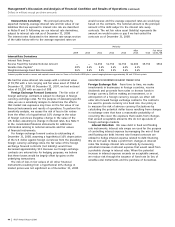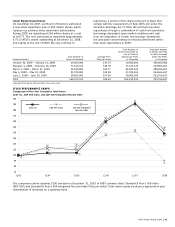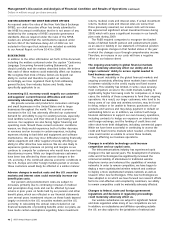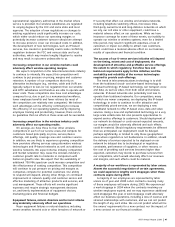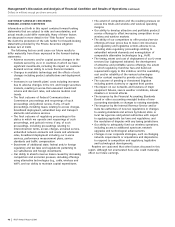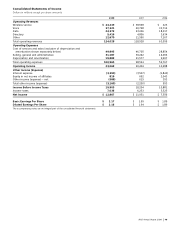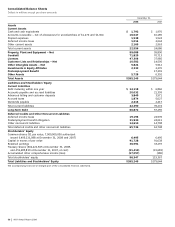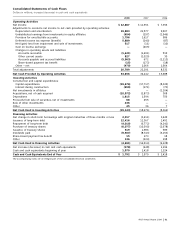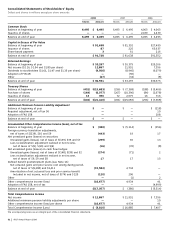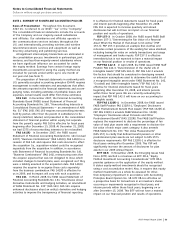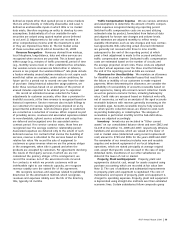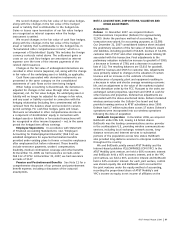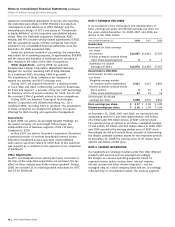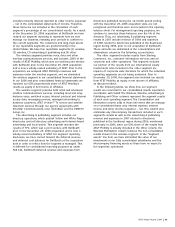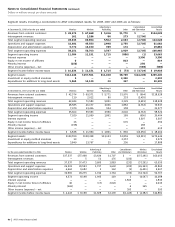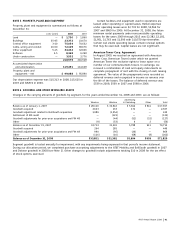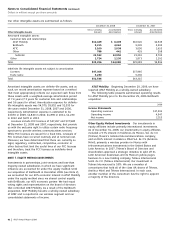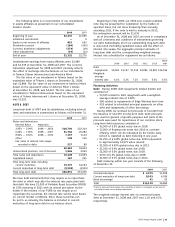AT&T Wireless 2008 Annual Report Download - page 55
Download and view the complete annual report
Please find page 55 of the 2008 AT&T Wireless annual report below. You can navigate through the pages in the report by either clicking on the pages listed below, or by using the keyword search tool below to find specific information within the annual report.
AT&T Annual Report 2008
| 53
Notes to Consolidated Financial Statements
Dollars in millions except per share amounts
NOTE 1. SUMMARY OF SIGNIFICANT ACCOUNTING POLICIES
Basis of Presentation Throughout this document,
AT&T Inc. is referred to as “AT&T,” “we” or the “Company.”
The consolidated financial statements include the accounts
of the Company and our majority-owned subsidiaries
and affiliates. Our subsidiaries and affiliates operate in
the communications services industry throughout the
U.S. and internationally, providing wireless and wireline
telecommunications services and equipment as well as
directory advertising and publishing services.
All significant intercompany transactions are eliminated in
the consolidation process. Investments in partnerships, joint
ventures, and less-than-majority-owned subsidiaries where
we have significant influence are accounted for under
the equity method. Earnings from certain foreign equity
investments accounted for using the equity method are
included for periods ended within up to one month of
our year end (see Note 7).
The preparation of financial statements in conformity with
U.S. generally accepted accounting principles (GAAP) requires
management to make estimates and assumptions that affect
the amounts reported in the financial statements and accom-
panying notes, including estimates of probable losses and
expenses. Actual results could differ from those estimates.
FAS 160 In December 2007, the Financial Accounting
Standards Board (FASB) issued Statement of Financial
Accounting Standards No. 160, “Noncontrolling Interests in
Consolidated Financial Statements — an amendment of ARB
No. 51” (FAS 160). FAS 160 requires noncontrolling interests
held by parties other than the parent in subsidiaries to be
clearly identified, labeled, and presented in the consolidated
statement of financial position within equity, but separate
from the parent’s equity. FAS 160 is effective for fiscal years
beginning after December 15, 2008. At December 31, 2008,
we had $375 of noncontrolling interests to be reclassified.
FAS 141(R) In December 2007, the FASB issued
Statement of Financial Accounting Standards No. 141 (revised
2007), “Business Combinations” (FAS 141(R)). FAS 141(R) is a
revision of FAS 141 and requires that costs incurred to effect
the acquisition (i.e., acquisition-related costs) be recognized
separately from the acquisition. In addition, in accordance
with Statement of Financial Accounting Standards No. 141,
“Business Combinations” (FAS 141), restructuring costs that
the acquirer expected but was not obligated to incur, which
included changes to benefit plans, were recognized as if they
were a liability assumed at the acquisition date. FAS 141(R)
requires the acquirer to recognize those costs separately
from the business combination. FAS 141(R) is effective for
us in 2009, and its impact will vary with each acquisition.
FAS 161 In March 2008, the FASB issued Statement of
Financial Accounting Standards No. 161, “Disclosures about
Derivative Instruments and Hedging Activities, an amendment
of FASBStatement No. 133” (FAS 161). FAS 161 requires
enhanced disclosures about an entity’s derivative and hedging
activities to improve the transparency of financial reporting.
It is effective for financial statements issued for fiscal years
and interim periods beginning after November 15, 2008.
FAS 161 is expected to increase quarterly and annual
disclosures but will not have an impact on our financial
position and results of operations.
FSP 157-3 In October 2008, the FASB issued FASB Staff
Position 157-3, “Determining the Fair Value of a Financial
Asset When the Market of that Asset is not Active” (FSP
157-3). FSP 157-3 provides an example that clarifies and
reiterates certain provisions of the existing fair value standard,
including basing fair value on orderly transactions and usage
of management and broker inputs. FSP 157-3 is effective
immediately but is not expected to have a material impact
on our financial position or results of operations.
FSP FAS 142-3 In April 2008, the FASB issued FASB Staff
Position FAS 142-3, “Determination of the Useful Life of
Intangible Assets” (FSP FAS 142-3). FSP FAS 142-3 amends
the factors that should be considered in developing renewal
or extension assumptions used to determine the useful life of
a recognized intangible asset under FASB Statement No. 142,
“Goodwill and Other Intangible Assets.” FSP FAS 142-3 is
effective for financial statements issued for fiscal years
beginning after December 15, 2008, and interim periods
within those fiscal years. We are currently evaluating the
impact that FSP FAS 142-3 will have on our accounting for
intangible assets.
FSP FAS 132(R)-1 In December 2008, the FASB issued
FASB Staff Position FAS 132(R)-1, “Employers’ Disclosures
about Postretirement Benefit Plan Assets” (FSP FAS 132(R)-1).
FSP FAS 132(R)-1 amends FASB Statement No. 132(R),
“Employers’ Disclosures about Pensions and Other
Postretirement Benefit” (FAS 132(R)). This FASB Staff Position
replaces the requirement to disclose the percentage of fair
value of total plan assets with a requirement to disclose the
fair value of each major asset category. It also amends
FASB Statement No. 157, “Fair Value Measurements”
(FAS 157), to clarify that defined benefit pension or other
postretirement plan assets are not subject to FAS 157’s
disclosure requirements. FSP FAS 132(R)-1 is effective for
fiscal years ending after December 2009. This FSP will
significantly increase the amount of disclosures for plan
assets in our 2009 Annual Report.
EITF 08-6 In November 2008, the Emerging Issues Task
Force (EITF) reached a consensus on EITF 08-6, “Equity
Method Investment Accounting Considerations.” EITF 08-6
provides guidance on the application of the equity method.
It states equity-method investments should be recognized
using a cost accumulation model. Also, it requires that equity
method investments as a whole be assessed for other-
than-temporary impairment in accordance with Accounting
Principles Board Opinion No. 18. EITF 08-6 is effective on
a prospective basis for transactions in an investee’s shares
occurring or impairments recognized in fiscal years, and
interim periods within those fiscal years, beginning on or
after December 15, 2008. This EITF will not have a material
impact on our financial position and results of operations.



